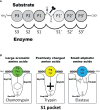Mast Cell and Basophil Granule Proteases - In Vivo Targets and Function
- PMID: 35865537
- PMCID: PMC9294451
- DOI: 10.3389/fimmu.2022.918305
Mast Cell and Basophil Granule Proteases - In Vivo Targets and Function
Abstract
Proteases are stored in very large amounts within abundant cytoplasmic granules of mast cells (MCs), and in lower amounts in basophils. These proteases are stored in their active form in complex with negatively charged proteoglycans, such as heparin and chondroitin sulfate, ready for rapid release upon MC and basophil activation. The absolute majority of these proteases belong to the large family of chymotrypsin related serine proteases. Three such enzymes are found in human MCs, a chymotryptic enzyme, the chymase, a tryptic enzyme, the tryptase and cathepsin G. Cathepsin G has in primates both chymase and tryptase activity. MCs also express a MC specific exopeptidase, carboxypeptidase A3 (CPA3). The targets and thereby the functions of these enzymes have for many years been the major question of the field. However, the fact that some of these enzymes have a relatively broad specificity has made it difficult to obtain reliable information about the biologically most important targets for these enzymes. Under optimal conditions they may cleave a relatively large number of potential targets. Three of these enzymes, the chymase, the tryptase and CPA3, have been shown to inactivate several venoms from snakes, scorpions, bees and Gila monster. The chymase has also been shown to cleave several connective tissue components and thereby to be an important player in connective tissue homeostasis. This enzyme can also generate angiotensin II (Ang II) by cleavage of Ang I and have thereby a role in blood pressure regulation. It also display anticoagulant activity by cleaving fibrinogen and thrombin. A regulatory function on excessive TH2 immunity has also been observed for both the chymase and the tryptase by cleavage of a highly selective set of cytokines and chemokines. The chymase also appear to have a protective role against ectoparasites such as ticks, mosquitos and leeches by the cleavage of their anticoagulant proteins. We here review the data that has accumulated concerning the potential in vivo functions of these enzymes and we discuss how this information sheds new light on the role of MCs and basophils in health and disease.
Keywords: CPA3; chymase; mast cell; serine protease; tryptase.
Copyright © 2022 Hellman, Akula, Fu and Wernersson.
Conflict of interest statement
The authors declare that the research was conducted in the absence of any commercial or financial relationships that could be construed as a potential conflict of interest.
Figures









Similar articles
-
Mast Cells and Basophils in the Defense against Ectoparasites: Efficient Degradation of Parasite Anticoagulants by the Connective Tissue Mast Cell Chymases.Int J Mol Sci. 2021 Nov 23;22(23):12627. doi: 10.3390/ijms222312627. Int J Mol Sci. 2021. PMID: 34884431 Free PMC article.
-
Human mast cells arise from a common circulating progenitor.J Allergy Clin Immunol. 2013 Aug;132(2):463-9.e3. doi: 10.1016/j.jaci.2013.02.011. Epub 2013 Apr 9. J Allergy Clin Immunol. 2013. PMID: 23582567
-
Granule proteases of hematopoietic cells, a family of versatile inflammatory mediators - an update on their cleavage specificity, in vivo substrates, and evolution.Biol Chem. 2014 Jan;395(1):15-49. doi: 10.1515/hsz-2013-0211. Biol Chem. 2014. PMID: 23969467 Review.
-
Mast cell proteases as pharmacological targets.Eur J Pharmacol. 2016 May 5;778:44-55. doi: 10.1016/j.ejphar.2015.04.045. Epub 2015 May 7. Eur J Pharmacol. 2016. PMID: 25958181 Free PMC article. Review.
-
The combined action of mast cell chymase, tryptase and carboxypeptidase A3 protects against melanoma colonization of the lung.Oncotarget. 2017 Apr 11;8(15):25066-25079. doi: 10.18632/oncotarget.15339. Oncotarget. 2017. PMID: 28212574 Free PMC article.
Cited by
-
Degranulation of Murine Resident Cochlear Mast Cells: A Possible Factor Contributing to Cisplatin-Induced Ototoxicity and Neurotoxicity.Int J Mol Sci. 2023 Feb 27;24(5):4620. doi: 10.3390/ijms24054620. Int J Mol Sci. 2023. PMID: 36902051 Free PMC article.
-
Discovery and Preclinical Characterization of Fulacimstat (BAY 1142524), a Potent and Selective Chymase Inhibitor As a New Profibrinolytic Approach for Safe Thrombus Resolution.J Med Chem. 2025 Mar 27;68(6):6108-6126. doi: 10.1021/acs.jmedchem.4c01819. Epub 2024 Nov 14. J Med Chem. 2025. PMID: 39541507 Free PMC article.
-
Allergy, Anaphylaxis, and Nonallergic Hypersensitivity: IgE, Mast Cells, and Beyond.Med Princ Pract. 2022;31(6):501-515. doi: 10.1159/000527481. Epub 2022 Oct 11. Med Princ Pract. 2022. PMID: 36219943 Free PMC article. Review.
-
Mast Cell Tryptase and Carboxypeptidase A3 in the Formation of Ovarian Endometrioid Cysts.Int J Mol Sci. 2023 Mar 30;24(7):6498. doi: 10.3390/ijms24076498. Int J Mol Sci. 2023. PMID: 37047472 Free PMC article.
-
Mast Cells as a Potential Target of Molecular Hydrogen in Regulating the Local Tissue Microenvironment.Pharmaceuticals (Basel). 2023 May 30;16(6):817. doi: 10.3390/ph16060817. Pharmaceuticals (Basel). 2023. PMID: 37375765 Free PMC article. Review.
References
-
- Angerth T, Huang RY, Aveskogh M, Pettersson I, Kjellen L, Hellman L. Cloning and Structural Analysis of a Gene Encoding a Mouse Mastocytoma Proteoglycan Core Protein; Analysis of its Evolutionary Relation to Three Cross Hybridizing Regions in the Mouse Genome. Gene (1990) 93(2):235–40. doi: 10.1016/0378-1119(90)90230-O - DOI - PubMed
Publication types
MeSH terms
Substances
LinkOut - more resources
Full Text Sources
Miscellaneous

